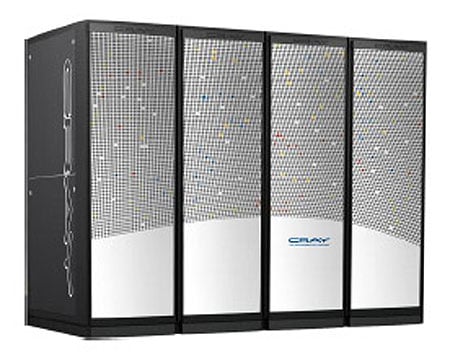Next Generation Cray 'Cascade' Supercomputer Will Run Kepler GPUs
Cray's future "Cascade" supercomputer will be a veritable powerhouse featuring Intel's Xeon Phi coprocessors built with 22nm 3D tri-gate transistors and Nvidia Tesla GPUs based on the chip designer's next-generation Kepler architecture, the company announced. This is a major win for Nvidia, and the latest in a long series of validations that GPUs have their place in supercomputing platforms.
"This is an exciting announcement for us, and for our customers, as it proves that we remain committed to our vision of integrating a range of advanced processing technologies into a single, scalable architecture," said Peg Williams, Cray's senior vice president of high performance computing systems. "Adaptive Supercomputing is about building a robust hardware and software environment that ultimately supports giving our customers choices. Adding the Nvidia Tesla Kepler-based GPUs, which are designed for computationally intensive HPC environments, into future versions of our Cascade system will give our customers the flexibility to choose from a variety of powerful accelerator options."

Sumit Gupta, senior director of the Tesla business unit at Nvidia, points out that Cray will be the first system to meld three key technologies consisting of Intel's latest Xeon CPUs, Cray's Aries system interconnect, and the new Kepler-based Tesla GPUs. The inclusion of Cray's Aries interconnect is particularly exciting in that it passes data through PCI-Express 3.0 bus interfaces regardless of which processors are used.
When completed, Cascade will be capable of sustained multi-petaflops performance on real-world applications. It's already snagged a $40 million contract to provide the Department of Energy's National Energy Research Scientific Computing Center with detailed analysis in environmental sciences, fusion energy, astrophysics, and several other areas.
"This is an exciting announcement for us, and for our customers, as it proves that we remain committed to our vision of integrating a range of advanced processing technologies into a single, scalable architecture," said Peg Williams, Cray's senior vice president of high performance computing systems. "Adaptive Supercomputing is about building a robust hardware and software environment that ultimately supports giving our customers choices. Adding the Nvidia Tesla Kepler-based GPUs, which are designed for computationally intensive HPC environments, into future versions of our Cascade system will give our customers the flexibility to choose from a variety of powerful accelerator options."

Sumit Gupta, senior director of the Tesla business unit at Nvidia, points out that Cray will be the first system to meld three key technologies consisting of Intel's latest Xeon CPUs, Cray's Aries system interconnect, and the new Kepler-based Tesla GPUs. The inclusion of Cray's Aries interconnect is particularly exciting in that it passes data through PCI-Express 3.0 bus interfaces regardless of which processors are used.
When completed, Cascade will be capable of sustained multi-petaflops performance on real-world applications. It's already snagged a $40 million contract to provide the Department of Energy's National Energy Research Scientific Computing Center with detailed analysis in environmental sciences, fusion energy, astrophysics, and several other areas.

